High vs Low Porosity Hair: Learn the key differences, signs, and the best care routine for each hair type to keep your strands healthy and hydrated.
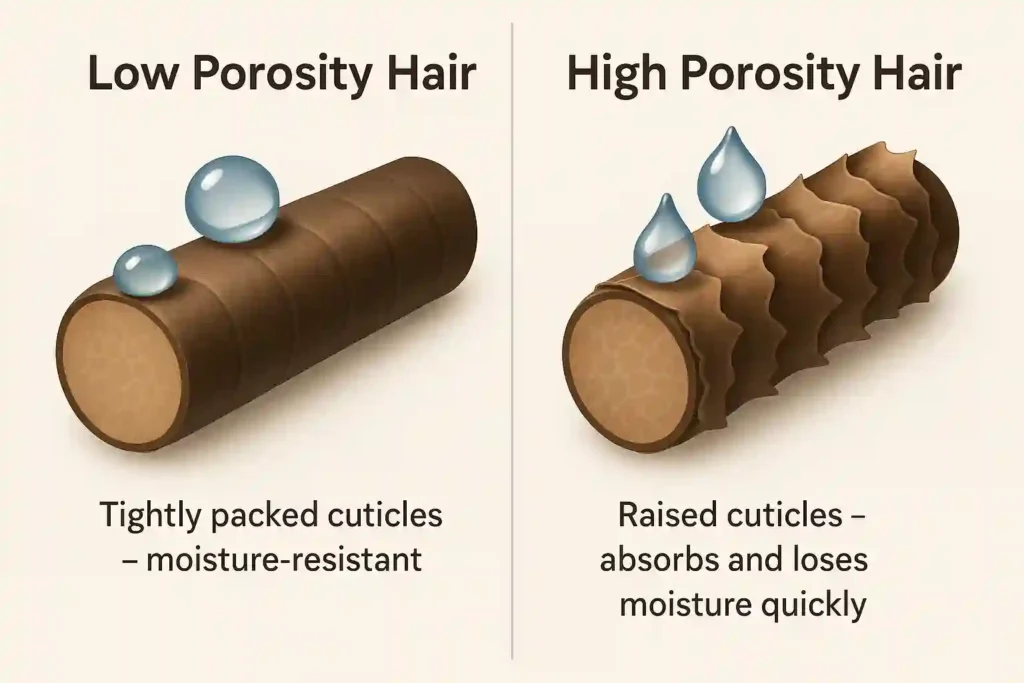
Hair porosity is an essential factor in your hair care routine. It refers to how easily your hair absorbs and retains moisture. This is determined by the structure of your hair cuticles – the outer layer of the hair shaft.
If you’re struggling with product buildup or find that your hair dries out quickly, it could be due to your porosity. Low porosity hair tends to resist moisture, while high porosity hair absorbs moisture but loses it just as fast.
This blog will compare high vs low porosity hair, helping you understand the key differences. By the end, you’ll know exactly how to adjust your hair care routine to match your porosity type, solving common issues like moisture retention or frizz.
Understanding your hair porosity is the first step to healthier, more manageable hair.
1. What Is Hair Porosity and Why Does It Matter?
Hair porosity refers to how easily your hair can absorb and retain moisture. It’s determined by the structure of your hair’s cuticle, which is the outer layer of the hair shaft.
If the cuticles are tightly packed, it’s harder for moisture to get in, and this is low porosity. If the cuticles are more open, moisture can enter quickly, but it’s also lost just as fast, this is high porosity.
Knowing your hair’s porosity is key to choosing the right hair care routine. For example, low porosity hair can be stubborn when it comes to absorbing moisture, which means you might need to use heat or lighter products.
On the other hand, high porosity hair needs richer products to lock in moisture and prevent dryness.
Understanding your porosity also affects your hair’s overall health. For instance, low porosity hair can lead to buildup from product that sits on the surface, while high porosity hair may suffer from dryness and frizz because moisture escapes quickly.
Knowing your hair’s porosity helps you pick the right products, giving you healthier, more manageable hair.
2. High vs Low Porosity Hair: Understanding the Key Differences
When it comes to hair porosity, the cuticle structure plays a big role in how your hair behaves. The cuticle is the outer layer of your hair, and its structure determines how easily moisture can enter and leave.
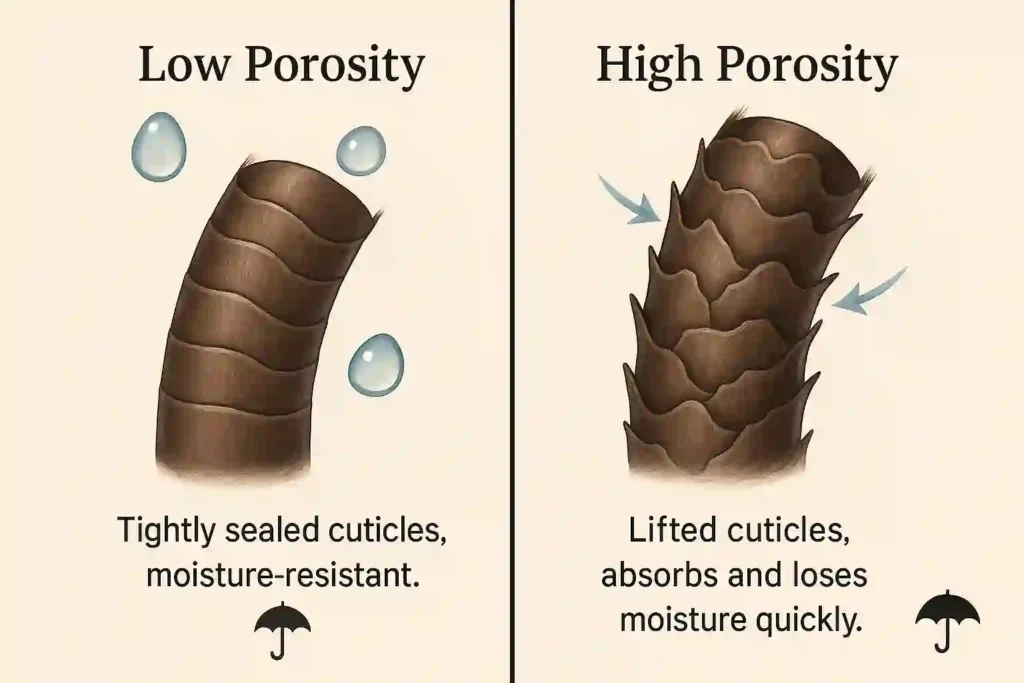
Low Porosity Hair:
In low porosity hair, the cuticles are tightly packed, which means moisture has a hard time getting in. Imagine your hair as a raincoat, water will just roll off, and it’s not easy for products to penetrate.
If you have low porosity hair, you might notice that it takes a long time to get wet in the shower, and products tend to sit on top of your hair instead of soaking in. You may also experience product buildup because the product doesn’t fully absorb, leaving your hair feeling heavy or greasy.
High Porosity Hair:
On the other hand, high porosity hair has loosely packed or even damaged cuticles. This allows moisture to enter the hair shaft quickly, but the downside is that the moisture escapes just as fast.
This means your hair can absorb a lot of water or product initially, but it can also get dry, frizzy, and dull easily because the moisture doesn’t stay locked in.
If you have high porosity hair, you might notice that your hair dries quickly after washing, but feels dry and frizzy soon after.
Moisture Absorption:
With low porosity hair, absorbing moisture is a challenge. Even though you may try to apply hydrating products, they don’t seem to penetrate your hair as they should.
Instead of soaking in, they may just sit on the surface. That’s why you might need to use heat or steam to help open the cuticles and allow moisture to enter.
In contrast, high porosity hair can absorb moisture quickly, but it loses it just as fast. This is why high porosity hair tends to feel dry and brittle, and it often needs heavier, more hydrating products to keep moisture from escaping.
Signs & Symptoms:
If you have low porosity hair, you might experience a few common signs, such as slow drying time and difficulty getting your hair wet in the shower.
You may also notice product buildup because the moisture isn’t able to enter, leaving products to linger on the hair.
For high porosity hair, common signs include frizz, dryness, and dullness. Your hair may feel very dry soon after applying moisture or styling products, as the moisture escapes too quickly.
Understanding these differences will help you identify the type of hair porosity you have, and ultimately, guide you in selecting the right products and hair care routine for your hair type.
3. How to Identify High vs Low Porosity Hair: Easy Methods
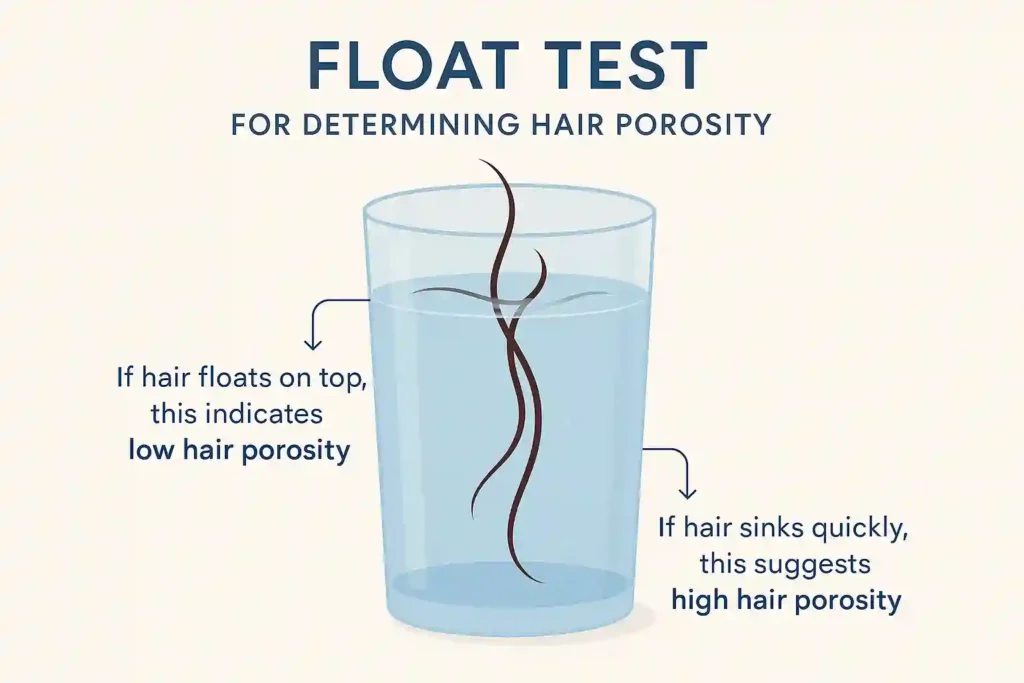
Identifying your hair’s porosity is simple and can help you find the best care routine. One of the easiest tests to try is the Float Test. Here’s how it works:
- Take a clean strand of your hair (preferably from the end of your hair).
- Place it in a bowl of water.
- Watch what happens:
- Low Porosity: If the strand floats on top or sinks very slowly, it’s likely low porosity. This means your hair resists moisture.
- High Porosity: If it sinks quickly, your hair is likely high porosity, meaning it absorbs moisture fast but loses it just as quickly.
Other Signs to Watch For:
You can also tell your porosity by the feel and behavior of your hair. For example, low porosity hair often feels smooth but can be hard to moisturize, while high porosity hair may feel dry and frizzy. Additionally, if your hair dries very quickly or feels overly damp, it might be high porosity.
Advanced Methods:
If you’re still unsure, some salons offer hair analysis to professionally determine your porosity. This is an accurate method that can take into account more than just the float test.
Identifying your porosity helps you choose the right hair care routine and products.
4. Hair Care Tips for Low Porosity Hair: Simple Solutions
If you have low porosity hair, you know that it can be tricky to get moisture into your strands. The tightly packed cuticles resist absorption, so it’s important to use the right products and techniques to help your hair thrive.
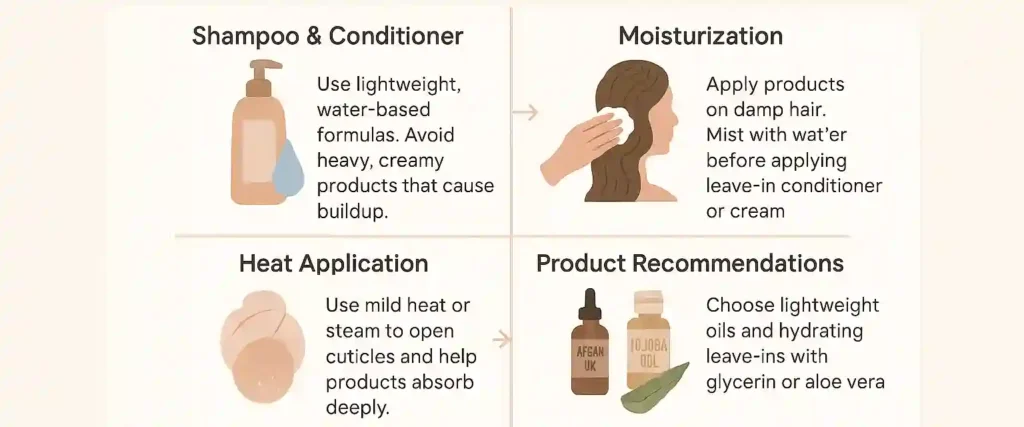
Shampoo and Conditioner:
Start with lightweight, water-based products. These are easier for low porosity hair to absorb and won’t cause product buildup.
Avoid thick, creamy shampoos or conditioners that can sit on the surface of your hair instead of soaking in. Look for shampoos with a low viscosity, which won’t weigh your hair down.
Moisturization:
For moisturizing low porosity hair, apply your products while your hair is still damp. Moisture is more likely to absorb when your hair is in this state, especially if you apply a leave-in conditioner or hydrating cream.
You can also mist your hair with water before applying your products to help lock in moisture.
Heat Application:
Using heat or steam can help open your hair’s cuticles, making it easier for your hair to absorb moisture.
You can use a steaming cap or place a warm towel on your head for 10-15 minutes while your conditioner sits in your hair. This simple step can make a big difference in getting moisture to penetrate.
Product Recommendations:
Go for lightweight oils, like argan oil or jojoba oil, which won’t weigh down your hair but still provide necessary moisture. Leave-in conditioners with glycerin or aloe vera are also great choices.
If you’re dealing with buildup, try a clarifying shampoo once a month to help clear out products that haven’t absorbed.
Common Mistakes:
One common mistake is using heavy creams or thick oils. These can sit on your hair without soaking in, leaving your strands feeling greasy or weighed down. Stick to lighter products and avoid layering too many.
By using the right products and techniques, you can give your low porosity hair the hydration it needs without causing buildup or weight.
5. Hair Care Tips for High Porosity Hair: Keep Your Strands Hydrated
If you have high porosity hair, you know that your strands absorb moisture quickly but also lose it just as fast. To keep your hair healthy, you’ll need a few extra steps to lock in moisture and maintain its strength.
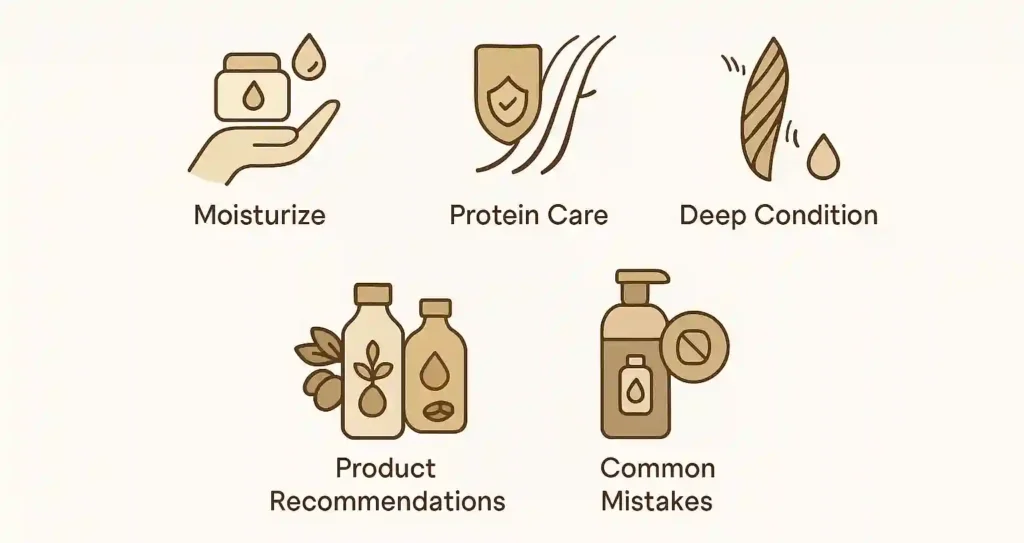
Moisturization:
The key to caring for high porosity hair is moisture. Use heavy creams, oils, and sealants to lock in hydration.
Products like shea butter, argan oil, and castor oil are perfect for sealing moisture and keeping your hair from drying out. Apply these products generously to damp hair to trap moisture in.
Protein Treatments:
High porosity hair can become weak and brittle over time. To strengthen it, try protein-based treatments once every 2-4 weeks.
These treatments help to fill in the gaps in the hair cuticle and restore elasticity. Look for products containing keratin or silk proteins to rebuild the hair’s structure.
Deep Conditioning:
Since your hair loses moisture quickly, regular deep conditioning is a must. Use a rich deep conditioner once a week to restore moisture balance and improve your hair’s elasticity.
Look for formulas with hyaluronic acid or glycerin, which attract moisture and help keep your hair hydrated longer.
Product Recommendations:
For high porosity hair, use rich moisturizers, leave-in treatments, and restorative masks. Products like moisturizing leave-ins and intense repair masks will provide lasting hydration and help protect your hair from damage.
Common Mistakes:
A common mistake is over-washing high porosity hair. Frequent washing can strip away the natural oils your hair needs to stay hydrated.
Instead, wash your hair 1-2 times a week, and use a co-wash (conditioner wash) if your hair needs refreshing.
By following these tips, you can help your high porosity hair stay moisturized, strong, and looking its best.
6. How to Keep Your Hair Healthy, No Matter Your Porosity
No matter your hair porosity, maintaining healthy hair is all about the basics. Here are a few tips to keep your strands in top shape:
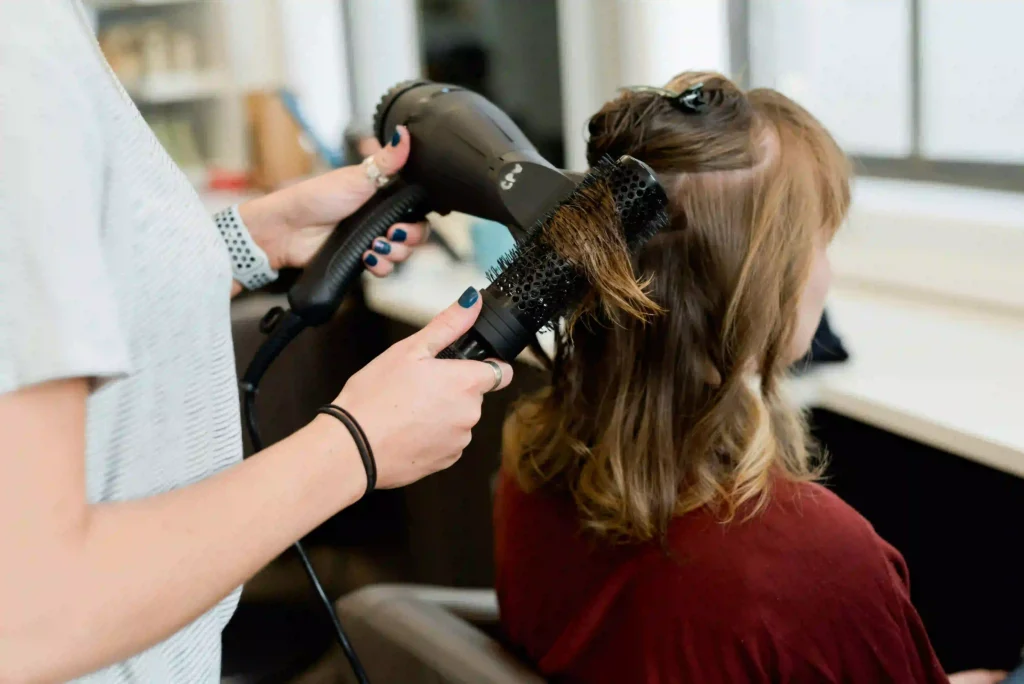
General Maintenance Tips:
First and foremost, regular trims are essential to remove split ends and prevent breakage. Avoid excessive heat styling to prevent damage, and always use a heat protectant if you do use hot tools.
Additionally, protect your hair from environmental damage by wearing a hat or using UV-protectant hair sprays when out in the sun.
Adapting to Changes in Porosity:
Your hair’s porosity can change over time due to age, chemical treatments, or environmental factors. For example, color treatments and heat can make your hair more porous.
If you notice your hair becoming more porous, adjust your routine by adding more moisturizing or strengthening products. Protein treatments can help restore hair’s strength, especially if your porosity has increased.
Porosity and Hair Color:
Your porosity affects how your hair handles color. Low porosity hair may resist hair dye and can be harder to color because the cuticles are tightly packed.
High porosity hair, on the other hand, absorbs color quickly but may also lose it just as fast. If you color your hair, use products designed for your hair’s porosity to help maintain color and keep your hair healthy.
By following these simple steps, you can keep your hair healthy and beautiful, no matter your porosity.
7. How to Care for Mixed Porosity Hair: Tailored Solutions for Every Strand
If you have mixed porosity hair, you might notice that some sections of your hair behave differently than others.
This means parts of your hair may have low porosity, while others have high porosity. It’s like having two different hair types in one, and it requires a more customized approach to hair care.
What is Mixed Porosity?
Mixed porosity means your hair has different porosity levels in different areas. For example, the ends of your hair may be high porosity (drier, more porous, and prone to frizz), while the roots might be low porosity (resistant to moisture).
This happens naturally or due to damage from heat styling, coloring, or environmental factors.
Care Tips for Mixed Porosity:
To care for mixed porosity hair, treat each section of your hair based on its needs. For high porosity ends, apply protein treatments or rich moisturizers to help seal moisture and prevent frizz.
For your low porosity roots, use lightweight products like water-based leave-ins or lightweight oils to avoid product buildup and encourage moisture absorption.
Special Considerations:
Since mixed porosity hair has different needs, it may require more time and attention. Personalized care is essential, such as using deep conditioning treatments on the high-porosity parts and gentle moisturizers for the low-porosity areas. Pay close attention to how your hair reacts, and adjust your routine accordingly.
Caring for mixed porosity hair can be a bit more time-consuming, but with the right approach, your hair can look and feel healthier.
8. Choosing the Right Products for Low vs High Porosity Hair
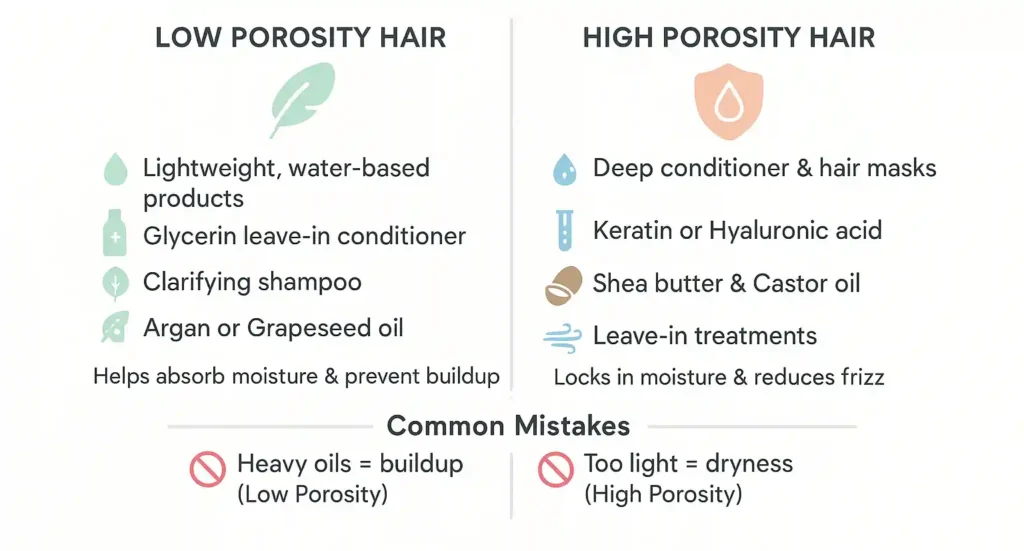
Choosing the right products for your hair’s porosity can make all the difference in maintaining healthy, hydrated hair. Whether your hair is low or high porosity, the right product can help manage moisture levels and enhance your hair’s texture.
Low Porosity Product Recommendations:
For low porosity hair, lightweight, water-based products work best because they are easier to absorb. Look for glycerin-based leave-in conditioners, which attract moisture without weighing your hair down.
Clarifying shampoos are also great for removing buildup, which is common for low porosity hair that resists absorption. When choosing oils, go for lightweight options like argan oil or grapeseed oil, which won’t sit on your hair and cause buildup.
High Porosity Product Recommendations:
If you have high porosity hair, you’ll want richer, moisturizing products to help seal in moisture. Deep conditioners and hair masks are your best friends, providing hydration and improving elasticity.
Look for products with keratin, hyaluronic acid, or shear butter for deep nourishment. Leave-in treatments and thick oils like castor oil help keep moisture locked in and reduce frizz.
Avoiding Common Mistakes:
One common mistake for low porosity hair is using heavy creams or oils that just sit on the surface.
These products don’t absorb well and can cause build-up. On the flip side, high porosity hair should avoid overly light products that might not provide enough moisture, leaving your hair dry and brittle.
Choosing the right products for your hair porosity type is key to maintaining healthy, shiny, and hydrated hair.
9. People Also Ask: Your Hair Porosity Questions Answered
Here are answers to some common questions about high vs low porosity hair:
How do you know if you have low vs high porosity hair?
To determine your hair’s porosity, you can try the float test. Simply drop a clean strand of hair into a glass of water.
If it floats, you likely have low porosity hair.
If it sinks quickly, it’s a sign of high porosity.
You can also check the spray test by spraying water on your hair. If it sits on top and takes time to soak in, you have low porosity.
If it absorbs quickly, your hair is high porosity. Other signs include how quickly your hair dries and how well it retains moisture.
Is frizzy hair high or low porosity?
Frizzy hair is often linked to high porosity hair. Because high porosity hair has open cuticles, it absorbs moisture quickly but also loses it fast, making it prone to dryness and frizz.
You may notice your high porosity hair feels dry and frizzy, especially after washing or being exposed to humidity.
What is worse, low or high porosity hair?
Neither low nor high porosity hair is “worse.” They each come with their own challenges. Low porosity hair can be difficult to moisturize and is prone to product buildup.
On the other hand, high porosity hair absorbs moisture quickly but loses it fast, leading to dryness and damage. The key is knowing your hair’s porosity and adjusting your routine accordingly.
What ethnicity has high porosity hair?
Certain ethnicities, such as those of African, Mediterranean, and Native American descent, often have higher porosity hair due to the natural shape and structure of their hair shafts. However, hair porosity is influenced by more than just ethnicity—it can also be affected by hair care practices and environmental factors.
Understanding your porosity helps you choose the right products and routines for healthier hair.
